The man who spoke to generations of Indians with his shuddh Hindi and clear diction looks back on what it took to become radio's best known name
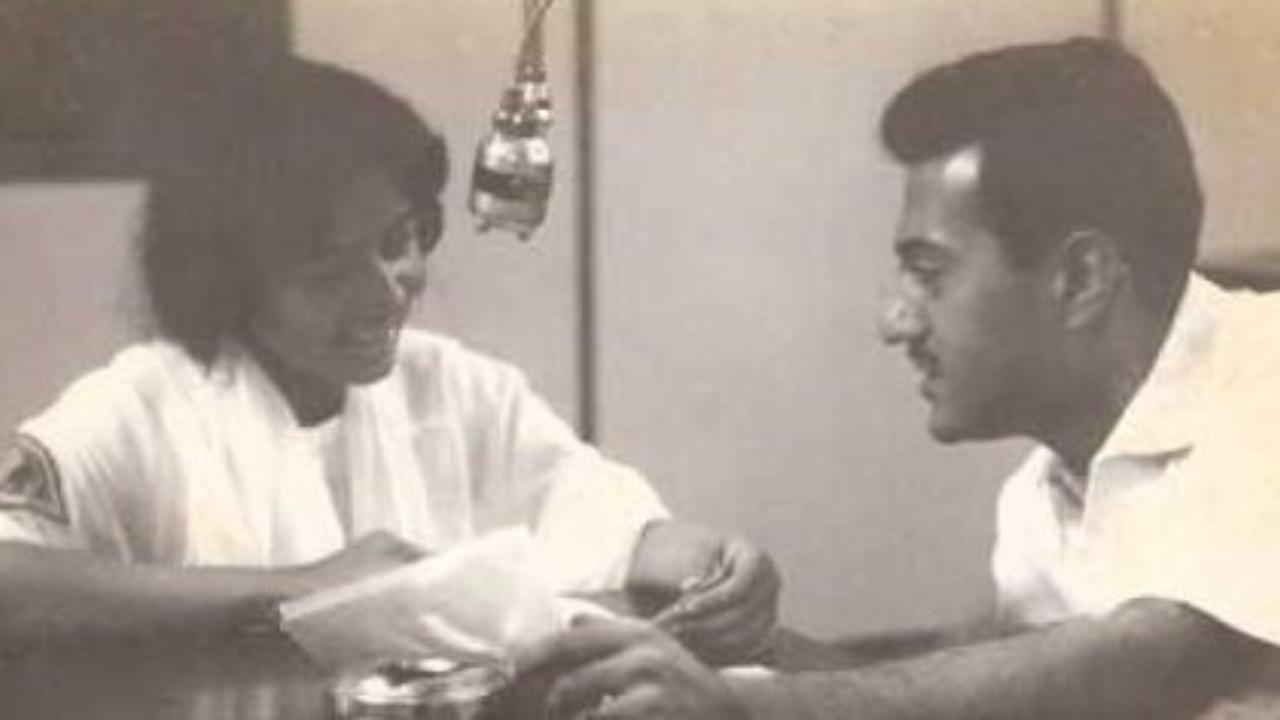
Ameen Sayani. Pic courtesy/Ameen Sayani
 "Behenon aur bhaiyyon…" Half a century ago, the words held us in thrall. The warmest greeting to waft from the radio, "Sisters and brothers" was a respectful inversion to cheer. Flipping the conventional "Bhaiyyon aur behenon" salutation with amazing adab was, of course, the redoubtable Ameen Sayani. With just-right cool at the mic and typically tender lilting tone, the man behind what must be the most mellifluous announcement in broadcast history, compered over 54,000 radio programmes, jingles and spots.
"Behenon aur bhaiyyon…" Half a century ago, the words held us in thrall. The warmest greeting to waft from the radio, "Sisters and brothers" was a respectful inversion to cheer. Flipping the conventional "Bhaiyyon aur behenon" salutation with amazing adab was, of course, the redoubtable Ameen Sayani. With just-right cool at the mic and typically tender lilting tone, the man behind what must be the most mellifluous announcement in broadcast history, compered over 54,000 radio programmes, jingles and spots.
Binaca Geetmala on Radio Ceylon defined him. The smash hit show presenting top listeners' choices in Hindi film songs saw spiralling lakhs of households tune in for this Wednesday evening hour. Kids collected "Binaca charms", miniature toy animals packed with Binaca toothpaste tubes. We named and secretly traded these plastic delights in hissy whispers at morning school assembly—why keep two of Slow the snail or Tarzan the tapir?
In middle class homes television was yet to invade, the radio crackled centre-stage. That orange flicker from my family's big Bush set seemed to blaze brighter at 8 pm midweek, caressed by the pitch-perfect inflection of "Main aapka dost Ameen Sayani bol raha hoon, aur aap sun rahe hain Binaca Geetmala." His infectious presence on air, the way he ruled its waves with passion and perception, had generations gravitate towards radio as a lifelong companion.
 Ameen Sayani at his Churchgate home, surrounded by trophies and film jubilee mementoes marking highlights of a stellar, internationally renowned 80-year innings in the broadcast world. Pic/Pradeep Dhivar
Ameen Sayani at his Churchgate home, surrounded by trophies and film jubilee mementoes marking highlights of a stellar, internationally renowned 80-year innings in the broadcast world. Pic/Pradeep Dhivar
When the British exited Ceylon, they left behind powerful short-wave transmitters belonging to Mountbatten's South-East Asia Command. Colombo used them for commercial radio offerings in Sinhalese, English, Tamil and the very lucrative Hindi.
Beginning in 1952 as a model version of what evolved as the ultimate countdown for Hindi film songs based on popularity, Binaca Geetmala was the Radio Ceylon rage. By the end of the '70s, its estimated weekly listenership was around 21 crores. Letters from people, pouring in by the gunny bagful, swelled to a staggering 65,000 per week. The rankings show boasted the most idolised radio station host any channel hoped to have. Geetmala shifted to Vividh Bharati on All India Radio (AIR) from 1989 to the mid-1990s.
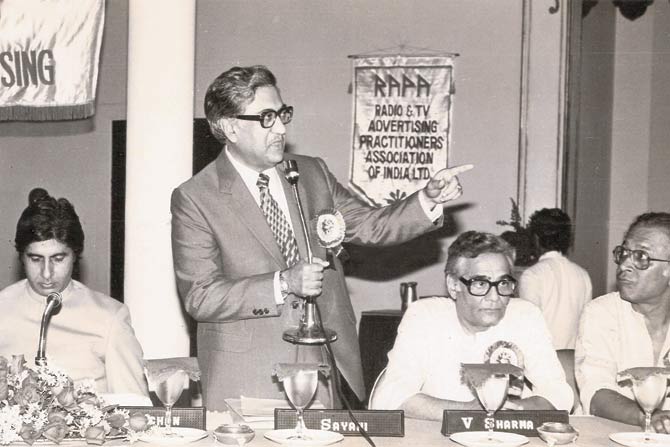
At a RAPA (Radio and Television Advertising Practitioners' Association) function with Amitabh Bachchan, and veteran voices Vinod Sharma and Pramod Dasgupta. Pics Courtesy/ Ameen Sayani
Sayani compered fashion shows and Made for Each Other couples' contests, acted in English and Gujarati theatre (the twinkle in his eye dances even deeper when he warbles ditties from Adi Marzban revues) and joined the country's sole secular choir. Formed in 1958 by Salil Chowdhury and Ruma Guha Thakurta, the Bombay Youth Choir performed songs of different Indian languages arranged in western choral patterns.
I interview the legend at his Colaba studio office where son Rajil devotedly ensures small boxes of nuts and fruit appear on his desk at regular intervals. The famed father's voice rings with every syllable of the joyful affability it always has, the tone deliberately upped to drown the din of road repair outside. Sipping chai from a mug printed "Quizzing is my kind of fun" (taking over the Bournvita Quiz Contest from elder brother and guru Hamid after his death in 1975, he swung it forward another eight years), Ameen Saab recounts how he became a household name throughout South Asia and parts of the Middle East and Europe.
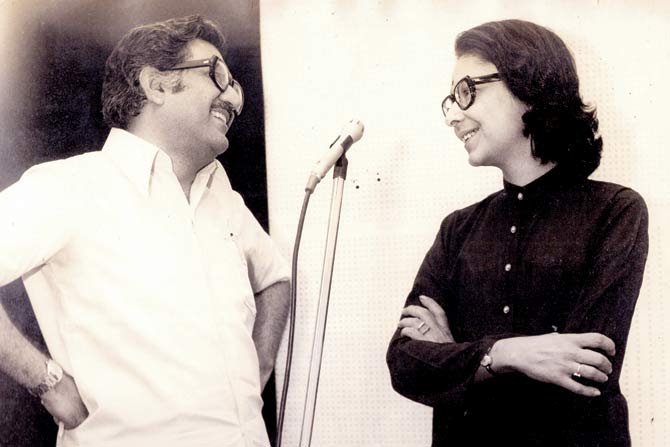 Ameen Sayani and wife Rama Mattu, an accomplished singer and voice artiste
Ameen Sayani and wife Rama Mattu, an accomplished singer and voice artiste
Appearing as an announcer in movies including Bhoot Bangla, Boxer, Teen Devian and Qatl, in 2016, after a sabbatical, he voiced the promo of Rustom with undimmed gusto. Inspiring how he follows a schedule as gloriously devoted to the medium as can be managed at 87, with sciatica pain. Calling to fact-check one morning, I find he has returned home at 2 am after attending a music awards night.
What else to expect from still-the-most-imitated announcer on the subcontinent? Ji haan, behenon aur bhaiyon, Ameen Sayani remains the quality benchmark in the radio and compering worlds. Over to the mesmerising voice….
 With actors Ashok Kumar and Pran
With actors Ashok Kumar and Pran
My grounding in Hindi resulted from helping my activist mother Kulsum produce Rahber editions from 1940 to 1960. A champion of literacy, she published Rahber (Leader) in Devnagri, Urdu and Gujarati from our Cumballa Hill home. The newspaper advocated simple Hindustani as a unifying language.
We never had much money but were well taken care of. My brother Hamid was six years older and Habib six years senior to him. Our father Jan Mohamed Sayani, a physician, treated poor patients for free, often paying for their medicines. A square, hand-cranked gramophone he brought exposed us to KL Saigal and Pankaj Mullick.
Going on air as a seven-year-old, well before my voice broke, was thanks to Hamid. At New Era School, I scored good English grades. It was an education encouraging Gujarati in the primary years, balanced by Rabindra Sangeet taught by Pinakin Trivedi and Shahaab Saab, the excellent Munshiji for basic Hindustani and Persian.
Entrenched in the broadcasting world, Hamid literally led me by the hand into the AIR station at Churchgate. Showing me a wire recorder, he said, "Speak, I'll play it back." I burst into "If I were Lord of Tartary" by Walter de la Mare. When he rewound, the recitation sounded tinny. Tutored for refined pronunciation and projection, understanding gliding diphthongs and triphthongs, I voiced children's shows. By 13, these progressed to roles in radio plays.
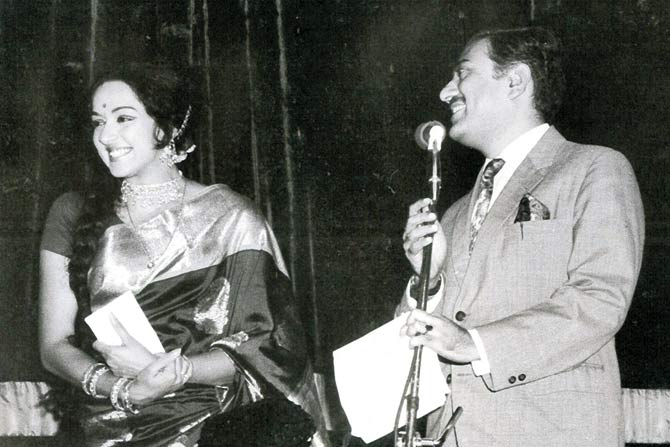
A light moment with Hema Malini
At school in Gwalior, I outgrew Bambai ki khichdi bhaasha. A kidney problem I developed worried my parents. At the recommendation of family friends, they moved me to the Scindia School in Gwalior as a Senior Cambridge boarder. Within a month of joining, I acted as a drunk waiter in The Crimson Coconut. There ensued several extracurricular activities giving me more confidence in Hindi.
On that dreadful day of Gandhiji's assassination, I made a firm resolution. News of those gunshots reached us in the Common Room. I was determined, as "naye Bharat ka naya naujawan", I would work in our raashtra bhaasha. Back in Bombay, the AIR chiefs heard I was keen on Hindi broadcasting. An audition proved that despite good reading of a script, my diction needed to lose English and Gujarati cadences.
Reward after rejection, Ovaltine Phulwari paved the path for Binaca Geetmala. Minister for Information and Broadcasting, BV Keskar's ban, from 1952, on film songs, sadly meant mass disposal of 78-rpm records. While AIR slid, Radio Ceylon bloomed. Daniel Molina, an American in Bombay, stepped in to opportunely establish Radio Advertising Services. Hamid ran its production wing, with greats like Balgovind Shrivastav and Manmohan Krishna.
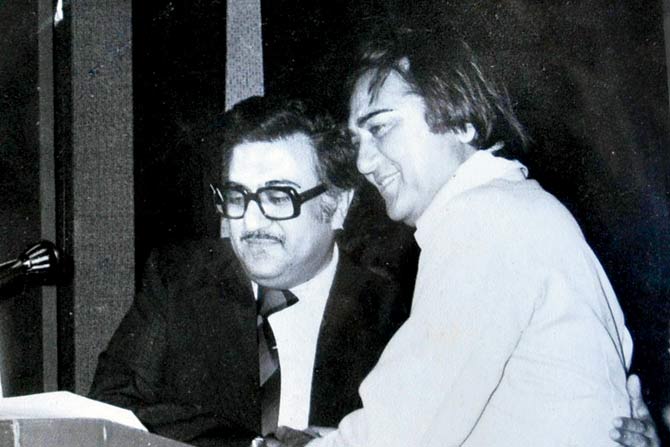 With Sunil Dutt, celebrating Geetmala’s silver anniversary
With Sunil Dutt, celebrating Geetmala’s silver anniversary
To improve my Hindustani accent, I attended sessions at the radio technology training studio in St Xavier's College. One day, an announcer for the Ovaltine Phulwari programme, which discovered promising singers, did not show up. Spotting me hang around, Shrivastavji asked if I would read three Hindi commercials. I punched them with the volume of Mark Antony's speech. "Chillaana kyon? Yeh radio programme hain, kushti ka akhaada nahi," I was advised and quietened.
"Happy-go-lucky Greg", as he was called, compered the English pop Binaca Hit Parade which spawned Geetmala. Greg Rostowski, whose family owned Hotel Nippon in downtown Colombo, boomed familiarly on the Commercial Service of Radio Ceylon and All Asia Service. Audiences flooded the station with requests for a similar Hindi film songs countdown. Binaca Geetmala was born. A notice in our office advertised the duties expected of a producer-scriptwriter-compere for the intended new show at a weekly fee of R25. I raised my hand and said, "I'll do it."
I longed for 200-300 letters from listeners of the first show in December 1952. I got 9,000. Having waited with bated breath for the inaugural broadcast, I prayed to God, Gandhiji and my mother for a decent amount of mail. On getting 9,000 letters, the entire agency jumped for joy. Enlisting friends to sort and sift from this flood, I readied winners' lists in time to be "live" from Radio Ceylon along with the second programme.
Meeting my wife Rama Mattu had an interesting prelude.
Quite remarkably, the New Era School principal, MT Vyas, had told my parents, "Your boy will marry a Kashmiri girl." Written in gold letters in my heart, that line turned reality when I met Rama, a voice artiste and singer, whose uncle headed Hindi music at AIR. Our son Rajil called her a music encyclopedia.
Among the virtuosos I struck lasting friendships with were Roshan, Kishore Kumar, Pancham, son of everyone's father figure SD Burman, Shankar Jaikishan and Kalyanji Anandji, whose stage shows I compered worldwide, including one which introduced Amitabh Bachchan.
The best radio programme is one you "see", with every listener feeling addressed individually by the host. The sincere presenter creates a personal equation, as binding as a lover's embrace, warm as a true friend's handshake. A compere should mind seven Ss: sahi (correct), satya (true), saral (simple), spasht (clear), sabhya (decent), sundar (beautiful) and swabhavik (natural).
Once among the most beautiful cities in the world, ours has visibly changed. I wonder at tourists visiting the Churchgate railway office, strangely enamoured by our dabbawalas! But Bombay has certainly enjoyed far better days.
Author-publisher Meher Marfatia writes fortnightly on everything that makes her love Mumbai and adore Bombay. Reach her at meher.marfatia@mid-day.com/www.mehermarfatia.com
Catch up on all the latest Crime, National, International and Hatke news here. Also download the new mid-day Android and iOS apps to get latest updates
 Subscribe today by clicking the link and stay updated with the latest news!" Click here!
Subscribe today by clicking the link and stay updated with the latest news!" Click here!










